
A Complete Guide to Email Marketing for Retailers
The retail industry is way more competitive than it was ever before. Why wouldn’t it be? The rise of e-commerce and growing interest in entrepreneurship have increased competition significantly.
To win the competition, you must stand out!
Email marketing is a powerful tool for winning e-commerce competitions. It is a productive marketing channel that helps you stand out and maintain constant communication with your customers, helping you build lasting customer relationships.
You may be an expert on every other marketing strategy. But if you didn’t master an e-commerce email marketing strategy, you’re not doing yourself any favor.
An e-commerce retailer has to have meaningful and friendly relationships with customers and this is why we’re here, with some inspirational e-commerce email marketing tips and ideas!
Let’s begin!
Why Do Retailers Need Email Marketing?
Email marketing is a great channel for all kinds of businesses. With a humongous amount of return on investment, it’s a marketing channel no one should miss out on.
The effectiveness of email marketing is even more amplified when used by retailers, here’s why:
- Gain more ROI: On average, email marketing has a return of 42$ for every 1$ spent. Depending on how well you use email marketing for your retail business, you could even surpass that average ROI.
- Get valuable feedback: Asking for reviews through emails got to be one of the easiest ways you can get valuable customer feedback. Customer feedback helps you gain valuable insight into what your customers want and insights help you grow as a brand and establish yourself as a market leader in your sector.
- Build a relationship with customers: Most of your company’s sales come from recurring customers. Building a relationship with your one-time customers might result in them turning into your repeat customers. You can do so by sending marketing emails like welcome emails, order confirmation emails, and follow-up emails to your customers.
To be frank, email benefits retailers in countless ways and what we’ve mentioned is just the tip of the iceberg. If you’re still not convinced, check out our article on the importance of email marketing.
How to Get Started with Retail Email Marketing
A retail business is a type of business that sells its offerings directly to consumers. So, basically, it’s a B2C business. Because it’s the last stage in the chain of distribution, retail businesses can benefit even more from email marketing considering emails can be a very personal means of communication
If you’re new to retail email marketing or just want to amp it up, here’s how to get started:
Build Your Email List
An email list is essentially the ground zero for all your email marketing campaigns. When starting out, you need to reach people through their email addresses. You need a list full of email addresses of real people who might be interested in your products and services.
Like every other starting point, you’ll face some hurdles and difficulties while building your email list. But starting with the right strategy will make it easier for you to build a high-quality email list.
Now let’s look at the strategies you could implement to build your optimal email list:
- Create enticing lead magnets: Lead magnets are something you can offer in exchange for your audience’s email address. To get people to fill out your form, you need to make an irresistible offer people can’t refuse.
- Put an opt-in form on your website: Place the opt-in form in a position where it grabs your user’s attention(e.g. sidebar, blog post, page, footer) and ask for the right information including their email address.
- Build personalized landing pages: Personalize landing pages to attract your prospects so that they are more inclined to share their information with you.
- Add a signup button to social media: Add a signup button to your social media handle for those who are interacting with you on a regular basis and want to know more.
Read this article to learn some more ways of building your email list
Segment Your Contacts
You’ve built an email list and begun sending them ample amounts of emails but your email campaigns aren’t paying off as much as they should. What went wrong? Why aren’t you getting the right amount of ROI from your emails?
It might be because you’re not sending the right emails to your email contacts.
How do you send the ‘right’ emails to your prospects?
Well, you start by dividing your email list into segments. There could be a variety of segments your contacts would fall into but let’s take a look at some of the most efficient ways of contact segmentation:
- Segmentation by demographics: Demographic segmentation is basically segmenting your customers using customer information including age, gender, marital status, and job title.
- Geographic segmentation: This simply means segmenting your customers based on their geographic locations.
- Segmentation by customer interest: While collecting customer information, you should collect data on what topics are they interested in and the frequency of emails they’d like to receive.
- Segmenting by engagement: When you collect email engagement metrics like open rate and click-through rate it becomes easy and straightforward to segment users based on how they interact with your marketing email. Based on user engagement, you might need to change your email content.
Send different messages, product recommendations, and brand announcements to different segments of people. One size fits all emails have proven to be a bad practice for marketing emails.
This article takes a deeper dive into segmentation in marketing
Utilize an Email Automation Tool
We all know the effectiveness of email marketing. It can provide miraculous returns. But, it’s a whole lot of work!
Starting from building your email list and segmenting it, setting triggers and rules, creating drip campaigns, scheduling emails, and finally getting the email sent to the intended recipient, even that’s not all!
You’re yet to start with nurturing emails which are a completely different set of work. For a growing business, it’s straight-up impossible to do all this manually. That is why email marketing automation is a must inclusion in your marketing strategy.
An email automation tool basically does all the work for you as you set the motion. Soon as you input your email list in the email automation tool’s database, it will automatically segment your list into its respective segments.
From there, you create your email automation funnels by setting the triggers, and the emails get automatically sent to your contacts. Just like that, everything gets done and dusted without any extra monotonous tasks to deal with from your end.
Design Mobile-friendly Emails
A marketing email is not all about its content, the design matters as well. According to statistics, 60% of users check their emails on mobile devices. With this in mind, the importance of designing mobile-friendly emails becomes clear.
There are an array of things to keep in mind while designing mobile-oriented email campaigns, such as:
- Testing emails for mobile devices: Before sending the actual email, test your emails for mobile visibility. Make sure the images in your email body fit the screen of mobile devices and don’t overlap the text.
- Writing short and catchy subject lines: This ensures most of the email body is visible on the first page ensuring maximum email content visibility.
- Embedding well-designed CTA’s: Put your calls to action in a clickable button that’s easier to find and click on a mobile device.
- Optimizing emails for readability: Write in short paragraphs and provide plenty of white spaces so mobile users can easily read the email.
Optimize Your Campaigns for Conversion
A buyer’s journey consists of 3 initial stages —
- Awareness
- Consideration
- Decision
Your leads will only consider buying from you once they’re aware of your existence. Only by considering does one make the purchase decision. Thus, all of your marketing efforts should be oriented toward getting your leads through their buyer’s journey as smoothly as possible so they get a positive impression.
When customers get a positive experience with your company, they become your loyal patrons who will recommend your business to others. This transition from one buyer stage to another doesn’t happen automatically. Each stage of the buyer’s journey needs to be optimized well so your leads can convert to customers.
You can optimize your email campaigns by:
- Sending personalized emails
- Writing effective subject lines
- Creating mobile-friendly emails
- Automating you emails
- Embedding effective CTA’s
- A/B testing your emails
12 Types of Emails Used by Retailers (Retail Email Examples)
Email marketing works because it’s trustworthy and has a personal touch. However, some e-commerce email marketing practices are almost necessary for keeping a professional relationship that builds upon trust.
With that said, let’s start with the below checklist on e-commerce email marketing campaigns:
Welcome the Subscribers
Suppose you invited your friends to come over. But when they arrived, you didn’t say a word to welcome them. How’d that be a decent thing?
Similarly, if a new subscriber joins your email list and you’re silent, that’s not a good user experience for your leads. Besides, the perfect time to reach out is when you get a new lead for your small business.
First impressions matter the most! So, if you want your subscribers to feel comfortable, send them a welcome email right away. Let them get to know you better while you find out what they expect from you.
Also Read: How to Send Custom Welcome Emails in WordPress
You can send text-only welcome emails or add interactive visuals. In short, any format you think suits your business well. Just keep everything professional. We’ll also recommend you employ an autoresponder to send welcome emails more effectively.
Personalize Your Emails
Reaching the target audience while maintaining your web store can be difficult. Also, more than one group can be interested in a single product. You can’t always take your business to everyone without knowing what they want! That’s exactly why we emphasize email personalization heavily.
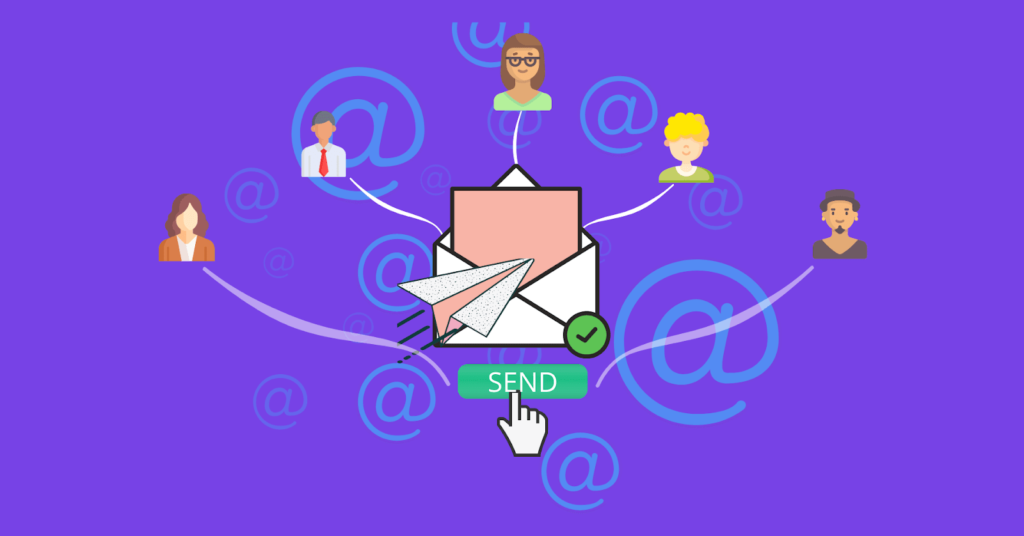
Personalizing your e-commerce email marketing campaigns according to the audience preference is the smartest trick. Tailor the emails to fit each customer.
Besides, it would be wise to keep an eye on customer wish lists and what products they usually buy. If they purchase the last remaining product from your stock, email them to notify them when the product is back in stock.
Sending emails about roller skates to an adult over 40 is less likely to make you any money! Know your target audience’s demography and lifestyle choices and segment the list by following customer preferences and shopping habits. You’ll be surprised by the results!
Keep Subscribers Engaged
People are way more distracted than before. You wouldn’t want your leads to forget about you and buy from somewhere else later, do you? Then keep them interested and inclined to shop from you frequently.
49% of people say that they get way too many marketing emails every day. So, it’s important to grab people’s attention on the first try. What can you do to grab attention on your first try? —Offer something they can’t ignore!
Let’s say you sent an email saying that you are offering free shipping, a user discount at checkout, or a free trial. You can bet that people will be swarming into your digital store! Applying these simple tricks in e-commerce email Marketing can help you develop a two-way relationship with customers.
Keep in mind that you simply want your email recipients’ attention. So, do it right, and don’t be too pushy.
Send Order Confirmation Emails
Do you just send a thank you email and not interact further after receiving an order? That is certainly not the way to go!
Your customers need the reassurance that you understand what they want and that they are getting the desired service from you. Emails for confirmation can be about orders, account creation or subscription, shipping arrangements, receipts, booking, appointments, etc.
Order confirmation emails have a high open rate; most people find these emails valuable. It can be an automated email that notifies customers that their order has been placed. You can also add what facilities they will be getting within the subscription confirmation emails.
Likewise, after order placement, you can email the buyers about shipping costs, delivery duration, weight, or amount. This helps you get remembered by your audience as a responsible e-commerce organization that genuinely cares about its customers.
Take a Survey
You don’t get an answer until you ask a question. Similarly, you can’t know what your customers experience on your e-commerce site if you don’t ask about it!
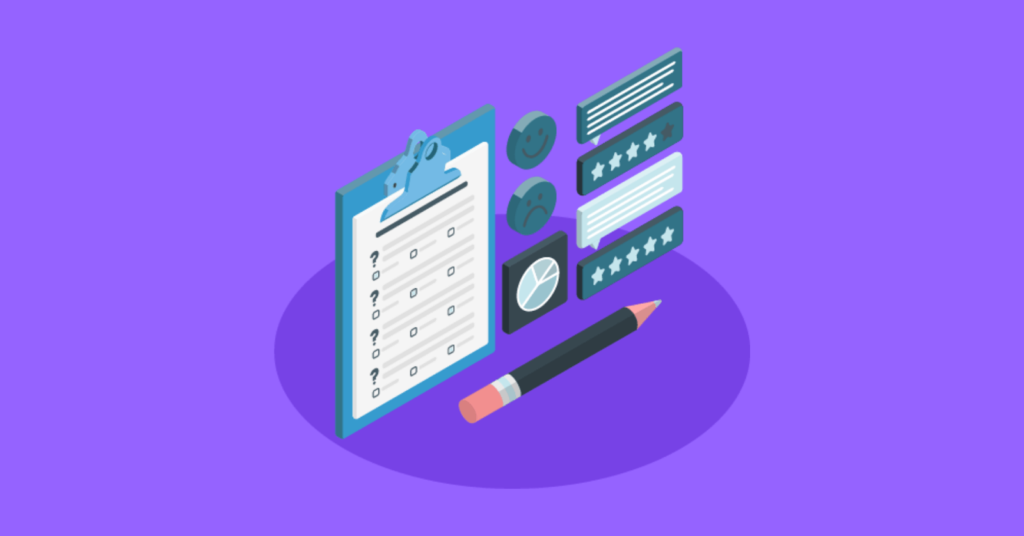
An email to survey customers’ shopping frequency, preferences, desires, and persona can significantly improve your user experience. However, you also need to give them something in return for their survey responses. A simple discount or gift might convince them into participating.
However, it is understandable that some people will just fill up the survey carelessly with false information for the free stuff. Instead of sending them survey campaigns, you can send the survey email after they have purchased and promise a gift on their next purchase.
Along with some excellent customer responses and reviews, this kind of e-commerce email marketing tactic can also improve sales!
Invite to Refer
Do you want free leads? —Encourage your consumers to refer you to their friends and family.
It’s the email list growth tactic used by many famous e-commerce owners. Studies show that 92% follow referrals from close ones. So it’s not simply a list growth tactic but also an extremely conversion-focused strategy.
The question is, why would someone recommend you if they’re not getting anything in return? If your customer refers you to others out of the goodness of their heart, then it’s excellent!
However, the best e-commerce email tactic would be implementing a referral discount. Take the Bombas referral program for an example. Their email contains clear directions for the “Refer a Friend” program and mentions the free pair of socks they’ll get.
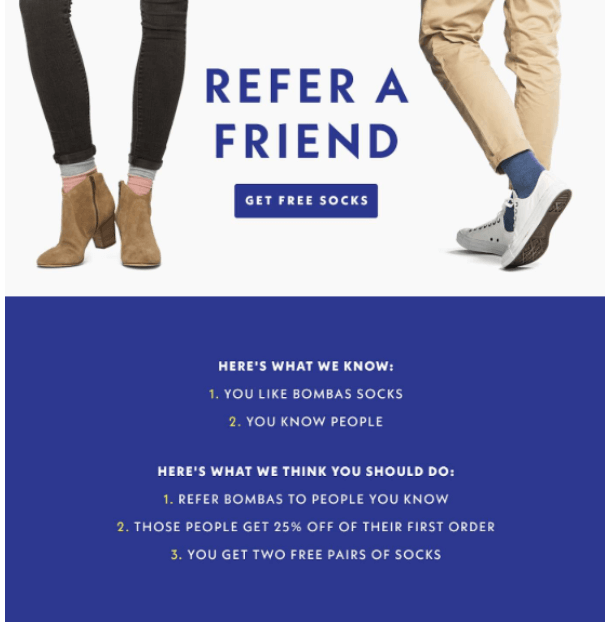
Even if you can’t give something away for free, you can most certainly assure them of a discount upon their next purchase.
“One customer, well taken care of, could be more valuable than $10,000 worth of advertising”. -Entrepreneur Jim Rohn
If you cater to your customer’s needs, you can get more customers when they start referring you to others.
Upsell and Cross-sell Products
Being an e-commerce business, you might have heard about upselling and cross-selling strategies. Or better, you might be already using upselling and cross-selling tactics in your store. These tactics are incredibly useful for increasing conversion rates.
What about upselling and cross-selling via emails? —are you already using them or not?
An email containing details of some of your top products right after customers buy something from you will keep them attentive to your store. This way, they might come back to buy some more.
Suppose an individual just bought a laptop from you. You can upsell them with an email about a more feature-packed laptop. Similarly, you can get into their inbox with wireless headphones for cross-selling items.
Show Your Appreciation
Just like confirmation emails, a “thank-you” email counts as an assurance. It’s not only for the sake of formality. It’s also about making your customers believe that you recognize and value them.
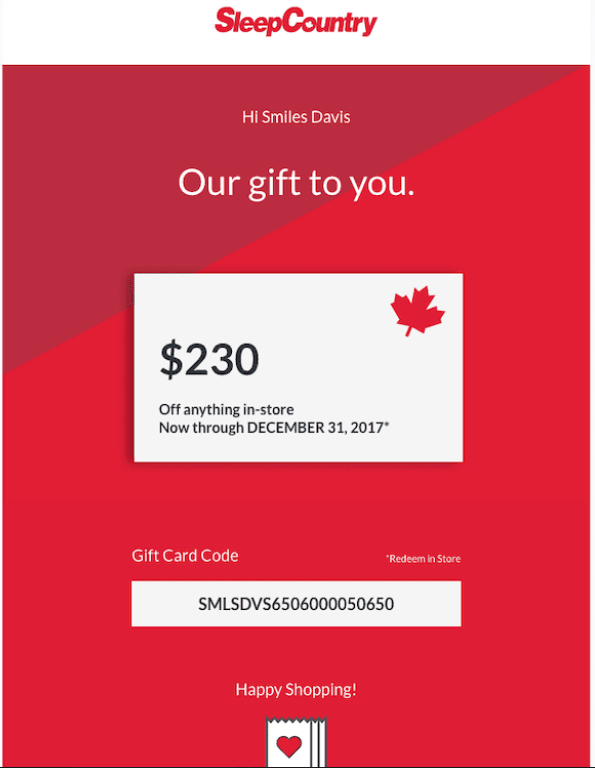
SleepCountry simply offers a discount as a thank-you. After the product is shipped, another thank-you note with some details about other products will bring good results as well. This increases the chance of selling more.
Similarly, right after a customer buys from you, you can send them a Thanksgiving email for shopping with you. You don’t have to wait for the customer’s purchase, though. Send a thank-you email anyway just to keep in touch or to appreciate them. A thank-you goes a long way!
Remember that new customer acquisition requires more money, effort, and time than customer retention. One or two effective customer retention emails will help you seal the deal perfectly.
Offer Discounts
Discounts are useful for a high customer retention rate. They help bind your buyers with exceptional deals and make them feel valuable and lucky.
However, you can’t go on offering everyone a discount on your products or services. It won’t be reasonable even if you have deep pockets. You should provide exclusive deals only to your loyal and regular buyers. And this way, you can have them come back more often.
Setting up a sale mid-season, exclusively for repeat customers, is another way of boosting conversion.
Pro-tip: Only focus on your subscribers who engage with your emails while giving out discounts!
Follow Up with Your Customers
As we said earlier, you can’t ignore your guests when you invite them in the first place! Not keeping up with your customers is the same thing.
Don’t forget about customers after subscription and single purchase. Drop by their inbox once in a while with your marketing newsletter, discount email, or new product details.
Besides, growing your email list won’t accomplish anything if subscribers tend to opt-out or disengage. To ensure lesser opt-outs, you can send them a follow-up email like, “We miss you here at X” “Here’s what you missed while you’re away,” etc.
You can also include a discount for the customer’s purchase resume. Simply win them back!
Find out some excellent follow-up email subject lines to engage customers with your emails
Keep Your Customers Notified
Every action has to have some reaction, right? Well, email notifications are a sort of advance reaction which stems from a user action. If a user gets on board– you welcome them, they tweak any security settings– you alert them, and other user actions for which users need to be notified, you should send it too.
Notifications are a powerful communication tool that creates a pathway for product teams to directly communicate with their customers. Moreover, notifications are probably the most influential tools that can be used by your company to drive more conversion and retain more customers.
Mostly, notifications provide a great user experience to your customers and reinforce trust in your services from the users and help build long-lasting relationships between you and your customers.
Here’s a great example of this:
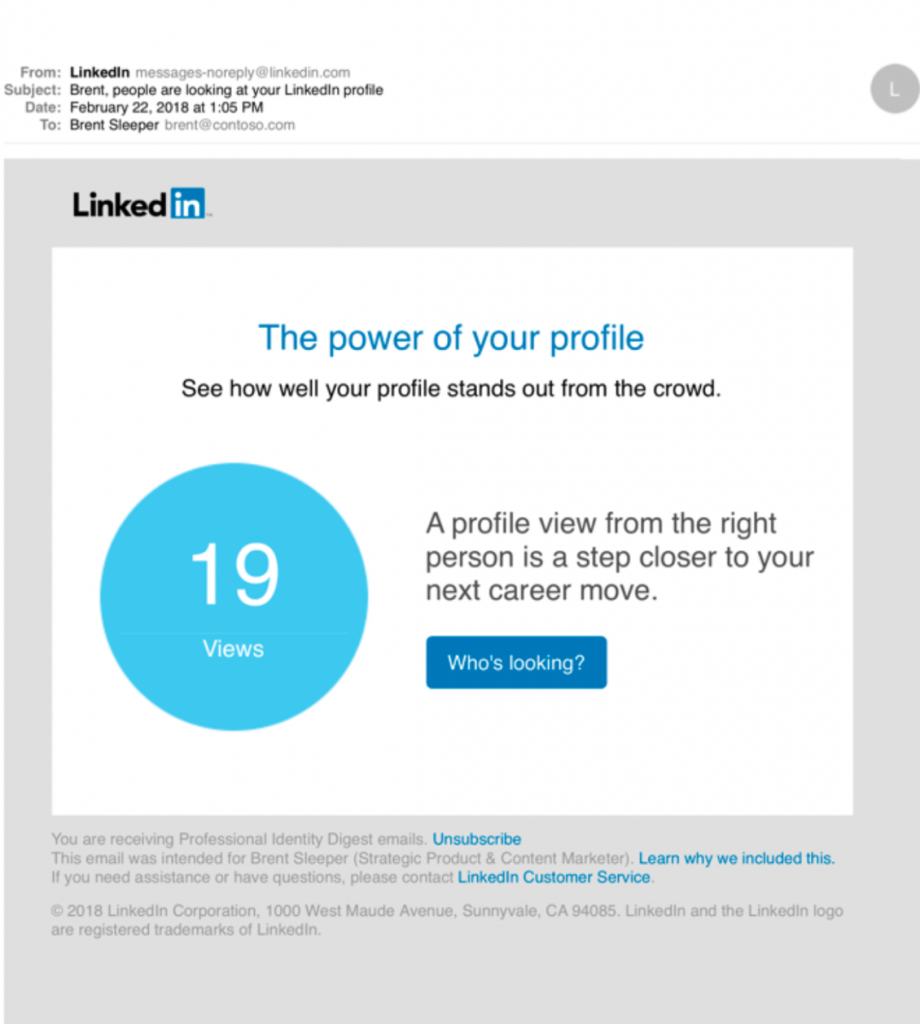
Send Seasonal Sales Emails and Greetings
Seasonal sales emails and greetings are an important part of retail marketing. It enables retailers to communicate with their clients on a more personal level and establishes long-term relationships with them.
Seasonal campaigns and greetings can help increase sales and revenue by promoting special offers, discounts, and new products. Making someone feel special on their birthday with a simple email and a special offer can result in a purchase!
Furthermore, these campaigns can help to instill a sense of urgency in customers, stimulating them to buy before the offer expires. It fosters a sense of community and belonging among its customers, which can aid in the development of brand loyalty.
Things to Avoid for Retail Email Marketing
Retail email marketing is pretty competitive. As a result, most retailers tend to make mistakes. Some of them are common and should be avoided at any cost. Here’s what you must avoid for retail email marketing:
- Don’t send the same marketing email to everyone on your list: Sending one-size-fits-all generic emails to all of your leads might lead you to a minuscule return on your investment. The rules are simple, segment your list and craft personalized emails for each of your customer segments. Avoid sending bulk meaningless emails, rather, send personalized and meaningful emails that your customers can relate to and get helped by.
- Don’t buy an email list: When starting to build an email list, buying an email list might seem like the easy way out. But you shouldn’t look for the easy way, rather, the effective way. Your end goal with building email lists is to convert them to your customers. For that, your email list should contain emails of real people who are potentially interested in your products. A randomly bought email list might not contain what you want in your email list. So, buying email lists gets a big NO from us!
- Don’t make your new subscribers wait for you: When a new subscriber gets on board, they want some acknowledgment from your end. A new subscriber needs to be groomed and nurtured in a systematic manner so they can convert into a customer. The grooming starts from day one, right when someone opts in. You will lose possession of your acquired leads who would rather opt for your competition than wait for you to respond. So, do not make your new subscribers wait for your response and instantly reach out to them after they opt-in.
- Don’t send inconsistent emails: If you want to gain the trust of your buyers and establish yourself in the market as a brand, you need a consistent brand image. From your email copies to your CTA’s, even in your brand color should follow a fixed pattern. You should also set your brand tone at the inception and stick with it so your customers can recognize you from a sea of other marketing emails they get sent every day.
Sending inconsistent, random emails to your customers will make you look like an unreliable, inconsistent brand, and your prospects may not decide to continue with your service.
Want More? – Craft, Test, and Track!
All sorts of e-commerce email marketing campaigns can only be successful if you work a little more on your e-commerce email templates. Since they are the ones your audience gets to see, you need to pay special attention to crafting, testing, and tracking emails.
Here are some more tricks to boost e-commerce conversion rates through email marketing.
- Design and craft an intriguing email that people will be tempted to open.
- Optimize your emails for mobile phones – 42% of users check emails on their mobiles.
- Use shorter subject lines to grab your audience’s attention.
- Test and proofread the emails for any false information, spam triggers, or silly mistakes before you send them. Read our article on why emails go to spam to avoid silly mistakes and spam triggers.
- Nail the conversion with a friendly approach.
- Grow the email list by catching subscribers from your website’s sidebar, header, footer, and during checkout.
- Track and monitor the results of your campaign.
Above all, try to empathize with your audience’s needs. No e-commerce can offer a solution without solving its audience’s problems. If your objective is to win the growing competition against other retailers, you must prioritize your customers over anything else!
E-commerce email marketing is pretty much open to all. And while we tried to cover the necessary ideas, you can come up with your own. But most importantly, you need to find out what emailing strategy your brand should have. Boosting the customer conversion rate with email marketing campaigns is not always easy. You might have to be invested a little more than you think. But in the end, it’s all worth it!
We hope this article helped you strategize your retail firm’s email marketing. If any particular strategy is working for you or if you have any queries, feel free to comment below!




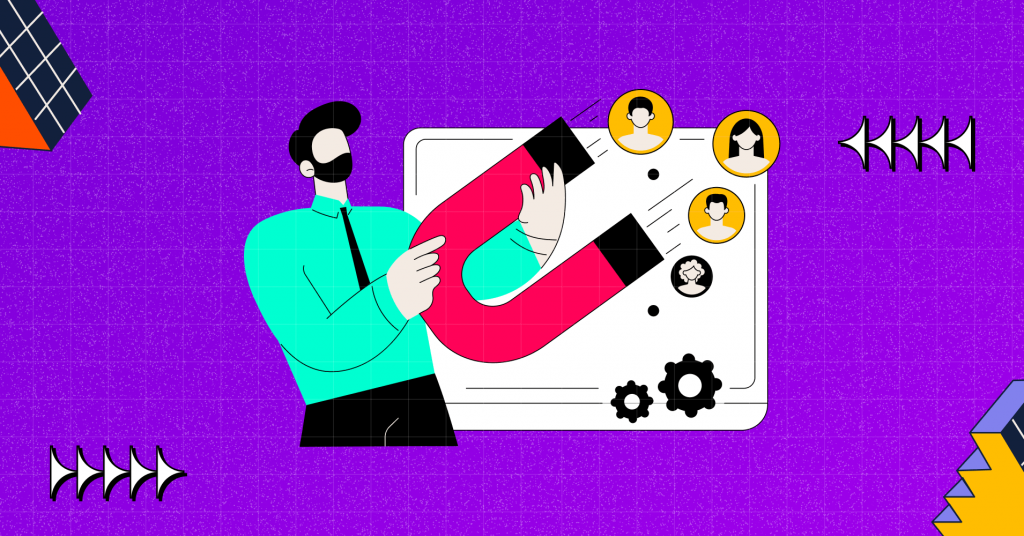
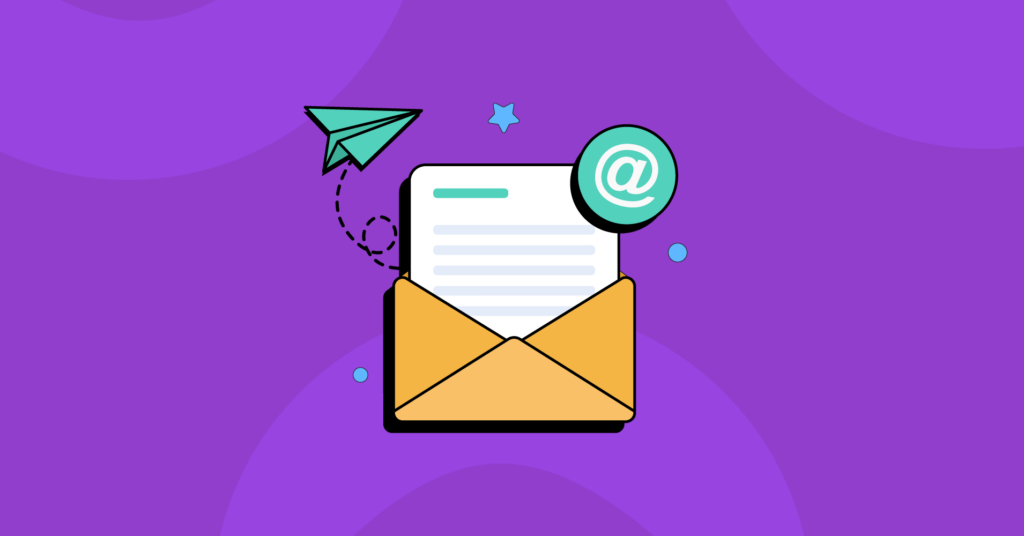

Leave a Reply